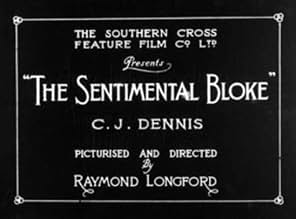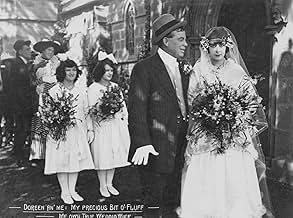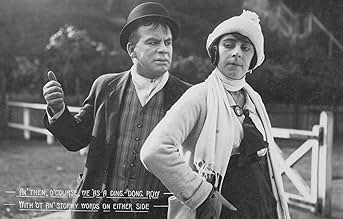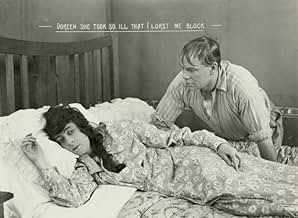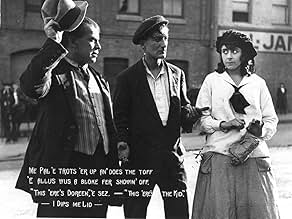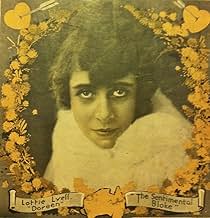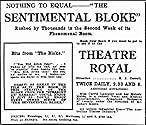Ajouter une intrigue dans votre langueA down-at-heal ex-convict undergoes an epiphany as he experiences the love of a good woman for the first time.A down-at-heal ex-convict undergoes an epiphany as he experiences the love of a good woman for the first time.A down-at-heal ex-convict undergoes an epiphany as he experiences the love of a good woman for the first time.
- Réalisation
- Scénario
- Casting principal
Avis à la une
The main line of Australian film making runs from this on through the Dad & Dave comedies (Ray Longford did some silent) Barry MacKenzie and Crocodile Dundee. While the later ones are a subject of embarrassment to the Australian film establishment, who nurture the fantasy of melding Political Correctness with CULTURE, this has been granfathered into an object of reverence.
It may have been a massive task for Ray Longford and his colleagues to get this far in 1919 Australia and maybe it's uncharitable to point out the limitations of their achievement but a film that traded these in comic stereotypes (endearing yokels, a thick ear working class hero who offers to duff up his rival for the beret wearing object of his affections and advises Romeo to "Put in the boot!" ) from any other source would be savaged. The acting is unshaded, the staging small scale and the coverage uninspired - mainly three quarter length two shots in uninteresting locations. The leads are not placed in the wider action which occurs as scene setting.
Poor Arthur Higgins does his best, imposing the close up of Lyall on the cut pumpkin and processing a moon into the beach sky but the film remains drab and stereotypical.
No one seems worried that THE SENTIMENTAL BLOKE is the contemporary of the work of Griffith, Tourneur and Sjöstrom when making extravagant claims for it. It's crude rendition of the Australian character continues - maybe he got it right - but shouldn't that worry someone?
The current, occasionally sharp restoration doesn't change these facts.
It may have been a massive task for Ray Longford and his colleagues to get this far in 1919 Australia and maybe it's uncharitable to point out the limitations of their achievement but a film that traded these in comic stereotypes (endearing yokels, a thick ear working class hero who offers to duff up his rival for the beret wearing object of his affections and advises Romeo to "Put in the boot!" ) from any other source would be savaged. The acting is unshaded, the staging small scale and the coverage uninspired - mainly three quarter length two shots in uninteresting locations. The leads are not placed in the wider action which occurs as scene setting.
Poor Arthur Higgins does his best, imposing the close up of Lyall on the cut pumpkin and processing a moon into the beach sky but the film remains drab and stereotypical.
No one seems worried that THE SENTIMENTAL BLOKE is the contemporary of the work of Griffith, Tourneur and Sjöstrom when making extravagant claims for it. It's crude rendition of the Australian character continues - maybe he got it right - but shouldn't that worry someone?
The current, occasionally sharp restoration doesn't change these facts.
10Mandyjam
In 1915 C.J.Dennis published a collection of poems telling the story of "The Sentimental Bloke". The poems are spoken by the Bloke himself, telling of his meeting with the girl who wins his heart, his courtship and marriage.
This black and white movie of the silent era captures the spirit of the poetry exactly. Near the beginning are the memorable words-
"The World 'as got me snouted, jist a treat! Cruel Forchin's dirty left 'as smote me soul, And all them Joys o' Life I 'eld so sweet Is up tha pole!
We soon have our Hero proclaiming-
'Er name's Doreen! Well, spare me bloomin' days! You could've knocked me down wiv 'alf a brick!
My only negative comment about this movie is that the written dialogue is not always easy to understand. It would be good to have the words dubbed.
This black and white movie of the silent era captures the spirit of the poetry exactly. Near the beginning are the memorable words-
"The World 'as got me snouted, jist a treat! Cruel Forchin's dirty left 'as smote me soul, And all them Joys o' Life I 'eld so sweet Is up tha pole!
We soon have our Hero proclaiming-
'Er name's Doreen! Well, spare me bloomin' days! You could've knocked me down wiv 'alf a brick!
My only negative comment about this movie is that the written dialogue is not always easy to understand. It would be good to have the words dubbed.
The Australian film industry, one of early cinema's most vibrant country for movie productions, was slowly diminishing after 1912 because of business consolidations in studio and distribution companies. By the mid-1920's, 94% of all films shown in Australia were American-made.
But one movie released in Oct. 1919, "The Sentimental Bloke," gave hope to Australia's big screen model. The feature film was a huge success not only in Down Under but in New Zealand as well as in the United Kingdom. The main ingredient for success was its natural portrayal of Australia's working class members, a populace movie audiences around the English speaking world related to.
"The Sentimental Bloke," based on the hugely popular 1915 verse novel 'The Songs of a Sentimental Bloke,' by C. J. Dennis, has its title cards within the movie containing verses taken directly from Dennis' work. Critics agree "The Sentimental Bloke" is Australia's best silent movie and one of the finest motion pictures to be produced Down Under.
Its storyline is fairly simple: a scruffy laborer (played by Arthur Tauchert, himself a manual worker before becoming a vaudeville comedian in the early 1900's) is jailed for illegal gambling, and meets a female pickle factory worker once released. The movie traces their up and down relationship. She reprimands him for his drinking episodes with his mates at the same time a more sophisticated man has his sights on her. The circumstances of the normal working class romance tickles the hearts of even the most jaded viewers, illustrating how movies can cause an upwelling of emotions to those who can relate to its characters.
What makes "The Sentimental Bloke" even more remarkable today is its city scenes were shot in the dock neighborhood of Woolloomooloo, Sydney, Australia, a rough working class area during the early 1900's. The close proximity to the ocean has recently gentrified the district to become a highly desirable place to live.
A sequel, "Ginger Mick," was produced in 1920 as well as a 1932 talkie remake. But none achieved the look or status of the 1919 original. Like many thought-lost silent movies that were recently discovered, "The Sentimental Bloke" was found by shear luck in the cubbyholes of the George Eastman House archives in 1973 and fully restored.
But one movie released in Oct. 1919, "The Sentimental Bloke," gave hope to Australia's big screen model. The feature film was a huge success not only in Down Under but in New Zealand as well as in the United Kingdom. The main ingredient for success was its natural portrayal of Australia's working class members, a populace movie audiences around the English speaking world related to.
"The Sentimental Bloke," based on the hugely popular 1915 verse novel 'The Songs of a Sentimental Bloke,' by C. J. Dennis, has its title cards within the movie containing verses taken directly from Dennis' work. Critics agree "The Sentimental Bloke" is Australia's best silent movie and one of the finest motion pictures to be produced Down Under.
Its storyline is fairly simple: a scruffy laborer (played by Arthur Tauchert, himself a manual worker before becoming a vaudeville comedian in the early 1900's) is jailed for illegal gambling, and meets a female pickle factory worker once released. The movie traces their up and down relationship. She reprimands him for his drinking episodes with his mates at the same time a more sophisticated man has his sights on her. The circumstances of the normal working class romance tickles the hearts of even the most jaded viewers, illustrating how movies can cause an upwelling of emotions to those who can relate to its characters.
What makes "The Sentimental Bloke" even more remarkable today is its city scenes were shot in the dock neighborhood of Woolloomooloo, Sydney, Australia, a rough working class area during the early 1900's. The close proximity to the ocean has recently gentrified the district to become a highly desirable place to live.
A sequel, "Ginger Mick," was produced in 1920 as well as a 1932 talkie remake. But none achieved the look or status of the 1919 original. Like many thought-lost silent movies that were recently discovered, "The Sentimental Bloke" was found by shear luck in the cubbyholes of the George Eastman House archives in 1973 and fully restored.
The Sentimental Bloke, to myself, is difficult to understand in terms of the inter titles. However, I can easily follow the movie and know what it want to communicate with audiences. In this movie, I can feel great sense of love. By this I mean I can see between somethings I would like to call 'Good' and 'Evil' sides of the Bloke fighting during the movie. The Bloke uses 'love,' as I already mentioned, as a weapon of the 'Good' to fight his 'Evil.' For example, when he met Doreen he decided to be a good husband and it appears again when he had a baby. As I can feel from this movie, the power of love no matter who you love, it is a great weapon to fight everything and to overcome any problems you may face.
It was a treat to watch this Australian silent, A Sentimental Bloke, with Lottie Lyell, who was called Australia's first movie star. An adaptation of the popular poem by Australian poet C.J. Dennis, the film was humorous and homey. It tells the tale of a ordinary "bloke" whose life is transformed by love. The Australian slang in the title cards made them a real challenge to read, but the acting style is so natural that it's not hard to understand what's going on. Arthur Tauchert, as the bloke, brings just the right amount of roughness and pathos to the part as he undergoes his transformation, and Lottie Lyell as Doreen, just the right amount of working girl toughness and maidenly sweetness. You can tell that she was ill during the shooting of the movie, and she died young of tuberculosis, bringing to an end a fine collaboration with film maker Raymond Longford.
Le saviez-vous
- AnecdotesThe film had a special revival screening at the Sydney Film Festival in 1955 at the University of Sydney.
- ConnexionsFeatured in Forgotten Cinema: The Golden Age of Australian Motion Pictures (1967)
Meilleurs choix
Connectez-vous pour évaluer et suivre la liste de favoris afin de recevoir des recommandations personnalisées
Détails
- Date de sortie
- Pays d’origine
- Langues
- Aussi connu sous le nom de
- Сентиментальный парень
- Lieux de tournage
- Adelaide, Australie-Méridionale, Australie(shots of sunsets & sunrises for the intertitles)
- Société de production
- Voir plus de crédits d'entreprise sur IMDbPro
Box-office
- Montant brut mondial
- 160 $US
- Durée
- 1h 46min(106 min)
- Couleur
- Mixage
- Rapport de forme
- 1.33 : 1
Contribuer à cette page
Suggérer une modification ou ajouter du contenu manquant

